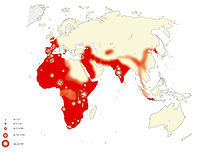Cleaver (archeology)
In archeology, a cleaver is a large, rectangular artefact that is usually worked on two sides and has a sharp, wide edge at one end. Such artifacts are subsumed under the generic term for two-sided tools, two-sided or bifaces. Classic, triangular hand axes also fall into this category .
Temporal spread
Bifaces - and thus also cleavers - appear for the first time in the advanced Oldowan (approx. 1.7 million years ago). This phase was defined using the Upper Bed I and Lower Bed II of Olduvai Gorge. However, cleavers are characteristic of the archaeological culture of the Acheuléen . Nevertheless, cleaver can still be found in the (European) Middle Paleolithic , for example in the Moustérien .
Manufacturing
Most cleavers were made from tees that were particularly long and large. Volcanic rocks such as lava , quartzite and (less often) flint were used as preferred raw materials . Since cleavers belong to the artifacts processed on both sides, the manufacturing steps for the production of conventional hand axes and cleavers are similar to a certain extent, but the cleaver does not have to work out the tip characteristic of the hand ax. Thus, the cleaver creates an almost rectangular artifact, whereas the hand ax has a triangular shape.
use
The artifacts were particularly suitable for slaughtering and processing animals (hunting prey). Cleavers were also used for woodworking. The intended use was verified through experimental tests.
literature
- Stanley H. Ambrose: Paleolithic Technology and Human Evolution. In: Science , vol. 291, 2001, pp. 1748-1753.
- Joachim Hahn : Recognition and determination of stone and bone artifacts. Introduction to artifact morphology. Volume 10, Verlag Archaeologica Venatoria, Tübingen 1991.
Individual evidence
- ^ Paul Bahn (Ed.): Dictionary of Archeology . HarperCollins Verlag, Glasgow 1992, p. 105.
- ^ Ian Tattersall , Eric Delson et al .: Encyclopedia of human evolution and prehistory . Garland Verlag, New York and London 1988, p. 91.
- ^ Mary Leakey : Olduvai Gorge: Excavations in beds I and II. 1960-1963. Cambridge University Press, Cambridge 1971, p. 5.
- ↑ Tattersall, Delson et al. 1988, p. 138.

